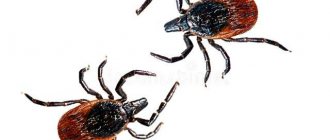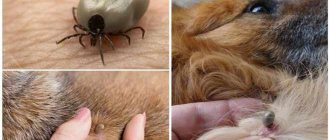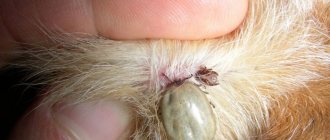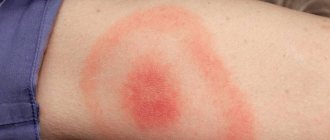What does the ixodid tick look like and what is dangerous?
Ixodid ticks belong to the class of arachnids. They have an oval brown body with four pairs of legs. The length of the female’s body in the hungry state does not exceed 4 mm. Males are smaller - about 2.5 mm in length. After saturation with blood, the parasite increases in size to 10–15 mm and acquires a light gray tint.
On the back of the insect there is a dense shield. The head is equipped with a proboscis with spikes that are directed towards the body. With its help, the tick pierces the skin of the victim and is firmly attached to it, so that it is not easy to pull it out.
When are ticks most active?
Ticks are activated when the thermometer rises to positive values. Their wintering takes place in the surface layers of the soil and in fallen leaves. Ixodid ticks cannot fly or jump, but simply sit on the grass or low bushes and wait for a cat, dog or person to pass by.
In direct contact with fur or clothing, mites cling to it with their paws, and then move closer to the body, guided by temperature.
Many people are mistaken when they think that a carrier of infection can only be picked up in a forest or park area with dense vegetation. In fact, mites are found wherever grass grows. Even in the city center, any person or pet can become a victim of arachnids.
Ticks are most active from early spring to early summer, as well as in August–September.
Diseases carried by ticks
Ticks are very dangerous as they are carriers of infectious diseases. These include:
- Hemobartonellosis is a cat disease in which anemia develops due to the death of red blood cells.
- Piroplasmosis is a deadly disease of cats and dogs caused by intracellular parasites.
- Anaplasmosis is more common in dogs than in cats. The disease is caused by intracellular bacteria and transmitted by ticks.
- Lyme disease affects dogs, cats, horses and humans.
- Tick-borne encephalitis (occurs in humans).
If the insect is not removed in time, there is a high probability that an infection will occur. Pathogenic bacteria and viruses are contained in the saliva and intestines of the bloodsucker.
Features of infection
A cat can catch a tick from the first thaw to the first frost in the fall. But nevertheless, there is a seasonality in outbreaks of bites by these insects. This time falls on May-June and August-September. On hot, dry days, ticks are more active than on rainy and cool days.
The tick lies in wait for its prey, passively waiting for it on the grass stems. As the cat passes by and touches the grass with its fur, it simply catches the tick. He doesn’t jump himself - he doesn’t know how. Well, then the tick moves to warm skin (it picks up the place of the greatest heat generation with its receptors).
Scientists have found that the tick senses warm-blooded animals and humans from a distance of 5 m. Therefore, these arachnids move closer to paths where there is some movement of potential victims.
Ticks are common not only outside the city, but also within its boundaries. Therefore, animals with access to the street are most susceptible to their bites. There are rare cases when a tick was found on a pet that did not leave the apartment. This could happen if owners brought the parasite in undetected on their clothing or shoes.
The ixodid tick has a proboscis with which it pierces the skin. The structure of the proboscis resembles a harpoon. The notches are directed towards the head. Therefore, it is impossible to pull out an embedded tick; a harpoon will not allow it.
The tick's proboscis has serrations that help the arachnid to hold tightly to the victim's skin.
Digging into the skin, the tick secretes saliva, which contains painkillers. Therefore, the bite goes unnoticed by the animal (and even by humans). The tick transmits the infection through saliva. Therefore, it is very important to regularly examine a pet that has access to the outdoors. Timely detection and removal of the parasite reduces the risk of infection.
How to detect a tick on an animal's body
Cats that are often outdoors should be examined daily. The easiest way to detect the carrier of the infection is when it has already sucked and drunk blood, since in this case it increases in size.
You should start your search where insects attach themselves most often:
- neck;
- ears;
- inner thighs;
- armpits;
- stomach.
In these places, the vessels are located close to the surface, and the skin is thin and easy to puncture. When examining a cat, you need to carefully part the fur, since the parasite is very small.
If you manage to find a tick, you should not stop searching - perhaps there is more than one tick on the cat.
If the carrier of the infection is not found during examination, this does not mean that it does not exist. Perhaps it has not yet attached itself, but is on the fur. It is advisable to comb the cat with a fine-toothed comb, sitting her on a white cloth. In this case, if the parasite falls out, it will not escape, because it will be clearly visible against a light background.
How to remove ticks from a cat at home
If a parasite is found, it must be removed correctly. There are several ways to remove a tick:
- using insectoacaricidal drugs;
- mechanically.
Before removing a tick from a cat, you should wear rubber gloves in case the parasite gets crushed during the procedure.
If you need to remove a tick from a kitten, you need to act in the same way as when bitten by an adult pet. The only difference is that kittens have thinner and more delicate skin, so you should be more careful.
Using insectoacaricidal drops
If the parasite has recently attached itself, you can remove the tick from the cat using drugs with insectoacaricidal action. To do this, drop a few drops of the product onto it. After about 20-30 minutes, the tick falls off on its own. After the procedure, the wound is treated with iodine or another antiseptic.
List of insectoacaricidal drugs:
- Leopard;
- Binakar;
- Dana Ultra Neo.
You can use any drops whose instructions indicate that they act on ixodid ticks.
Mechanically
A tick that has attached itself several hours ago and has already drunk blood is more difficult to pull out. In this case, you will have to remove it mechanically. You need to act very carefully so as not to crush the parasite and tear off the head.
Tweezers
Before removing a tick from a cat's body, tweezers must be disinfected with chlorhexidine solution or medical alcohol. Next, the parasite is clamped at the very base of the head and slowly turned in any direction until the proboscis can be pulled out. It is important to pull it out very carefully so as not to crush the bloodsucker.
Special devices
The veterinary pharmacy sells special tools that can be used to safely remove the tick from the cat's body. They come in three types:
- Tick Twister Unclean hook. Outwardly, it is similar to a nail puller and differs only in its miniature size. The device is placed under the tick's body so that it is in the slot. Then rotate the hook in any direction and pull out the parasite.
- Trix Tix Lasso loop. It looks like a ballpoint pen with a button at the top. When you press it from below, a loop appears, which must be placed over the tick’s body as close to the cat’s skin as possible. With the help of a return mechanism, it is tightened and tightly clamps the parasite. Next, you need to pull it out with rotational movements.
- Pro Tick Plate. A very simple device for gripping a tick that resembles a bottle opener. The narrow part with the slot is placed under the parasite so as to press it close to the cat’s skin. To pull out an arthropod, you need to turn the plate to the right or left until the proboscis comes out.
Thread
Another way to remove a tick is with a thread. The abdomen of the parasite must be tied with a thick thread and then twisted. This method is not entirely safe. Often during the procedure, the torso is torn off, but the head remains in the skin.
Expert opinion
Chepa Natalya Semenovna
Veterinarian
Ask an expert
To unscrew the tick, you can use improvised means, for example, a clip from a bread package. To do this, you need to make a narrow wedge-shaped cut in it, then the device can be used as a pliers remover. If you managed to remove the entire tick, you need to place it in a container (you can use a sample collection container or a regular syringe) and deliver it to a veterinary laboratory. This is necessary to identify the parasite. After all, different types of ticks can be carriers of different diseases. There is no point in delivering a tick if it is not completely removed. Dangerous vector diseases such as babesiosis, anaplasmosis, and borreliosis are recorded much less often in cats than in dogs. However, where dogs suffer from these diseases, cats may well become infected as well.
Twisting technique
To prevent the head from coming off during the procedure and to carefully unscrew the tick, adhere to the following recommendations:
- immobilize the cat;
- grab the tick as close to the animal’s skin as possible;
- turn your body left or right until your head comes out.
It doesn't matter which way you rotate the parasite to get it out - clockwise or counterclockwise. It will be possible to remove it in any case, since when the body is rotated, the notches on the proboscis will change their position and the tick will come off.
Common Mistakes
When removing ticks from cats, many people make serious mistakes. For example, they remove the parasite with their fingers or pour it with oil. If there is no device at hand that makes it easy to remove the tick, some cat owners try to do it with their hands. This is not the best idea - if you grab the body from both sides, you can easily crush the parasite. Then its contents will get into the wound. If the tick is infected, the cat will get sick.
Another mistake is to pour oil on it before removing a tick from a cat. Many people think that then the parasite will have nothing to breathe. The tick will actually suffocate under the oily film.
However, before he dies, he will regurgitate the contents of his intestines, which will end up in the wound. In this case, the risk of infection will increase several times. For this reason, you cannot use other oil-containing substances (gasoline, kerosene) to pull out the arachnid.
When should you see a doctor?
If an animal develops paralysis, it must be urgently taken to a specialist.
If a cat develops symptoms such as fever, nausea, weakness, or paralysis after being bitten by a tick, you should immediately consult a veterinarian. The outcome of your pet’s treatment depends on timely medical care. Doctors recommend not removing an insect yourself if it has attached itself to a hard-to-reach place, such as the eyelid, anus, or genitals.
Actions after parasite removal
Immediately after removing the tick, the wound is filled with chlorhexidine, hydrogen peroxide or another antiseptic. You need to inspect it periodically. If the bite site turns red or festered, the cat should be taken to a veterinary clinic.
The removed tick should be placed in a vial, tightly capped and sent to the laboratory for examination. If this is not possible, then it is better to destroy the parasite by burning it. Do not throw the insect down the drain or crush it.
After removing the tick, you should thoroughly wash your hands with soap and wipe them with alcohol. This will help avoid contracting an infection.
It is important to monitor the cat's condition. Symptoms of the disease may not appear immediately, but 1–4 weeks after the parasite has been removed. The owner of the animal should be alert to:
- increased cat body temperature;
- lethargy;
- lack of appetite;
- blanching of the mucous membranes;
- bowel dysfunction;
- unkempt appearance of the coat.
All diseases that the ixodid tick carries are treatable. The main thing is to pull out the bloodsucker in time, and if symptoms of the disease are detected, immediately seek veterinary help. You should not hesitate if signs of infection are found in kittens. They have weak immunity, so the disease develops faster.
What not to do
When carrying out the procedure, we strongly do not recommend working with bare hands. Using gloves will protect a person from accidental infection and reduce the risk of damage to the pet’s skin. If there is a suspicion that an insect is infected, then you need to pack it in a sealed container and take it to the laboratory. This must be done no later than 2 days after the bite. According to statistics, every 5 ticks turn out to be a carrier of a dangerous infection.
- The use of oil and other lubricants is not recommended. Many people believe that if you lubricate the tick and the bite site with Vaseline, oil or kerosene, it will come out on its own. But that's not true. The insect may suffocate and die, making extraction more difficult.
- Do not suddenly remove the insect. If the head remains under the skin, inflammation at the site of the bite or infection of the entire body may follow. This is due to the fact that it is the tick’s saliva that is the repository of dangerous microorganisms and infections.
- You can't push him. When crushed, a tick is much more dangerous. If liquid from a crushed tick gets on the skin, infection cannot be avoided. The most reliable way to kill a tick is to burn it or place it in alcohol.
Preventing tick attacks
Prevention includes regular examination of the pet, even if the cat does not go outside. Special means are used to protect domestic animals:
- Insectoacaricidal drops on the withers are considered the most effective. They are applied once a month. However, such drugs are not suitable for kittens under 2 months of age.
- Anti-tick sprays contain substances whose odor repels bloodsuckers. However, there is one drawback - after spraying, the animal can lick the toxic composition from the fur. To avoid troubles, it is better to apply it in the same place as the drops - on the withers.
- Another method of protection is a collar with an insectoacaricidal composition. It is absolutely safe even for small kittens.
If a cat goes out for a walk freely, the owner should be on alert - in spring and summer there is a high probability of picking up a tick. You need to make it a rule to examine your cat every day.
It is important to remove a discovered bloodsucker as quickly as possible. The sooner this is done, the less likely it is that your pet will become infected with an infectious disease.











